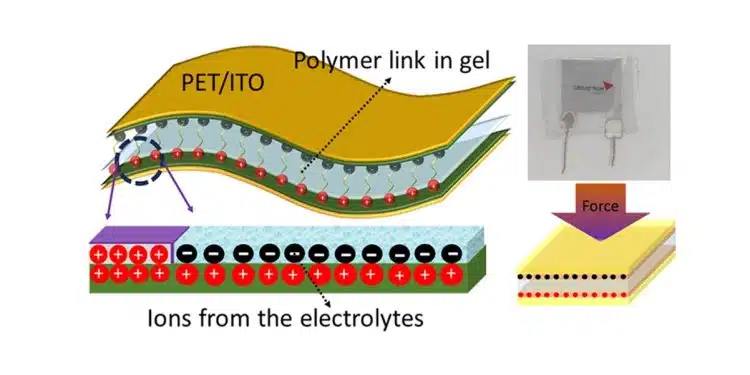Researchers from Edinburgh Napier University, UK published in Applied Physics Letters its study of transparent ionotronic-based flexible electrochemical supercapacitors using gel electrolytes and indium tin oxide (ITO) based transparent flexible electrodes.
Flexible, transparent ionotronic devices, which employ hydrogels to conduct and transmit electrical signals, have been explored in applications ranging from e-skin to loudspeakers. To reach their full potential, the capacitors that power such devices must also be flexible and transparent.
Electrolytes are often employed for this purpose because of their ionic properties, but selecting the ideal candidate for an electrochemical capacitor requires balancing optimal ion storage, efficiency, and transparency. Kumar et al. compared the performance of gel electrolytes prepared with different salts in a polyvinyl alcohol solution. They found that lithium chloride outperformed both sodium chloride and potassium chloride.
The polymer gel is sandwiched between indium tin oxide-coated polyethylene terephthalate electrodes and acts as a conductive channel for ions.
“This device works based on the supercapacitive principle,” said author Libu Manjakkal. “When an external potential is applied, the charge separation on the interface of the gel electrolyte and transparent electrode leads to energy storage.”
When an external force is applied to the capacitor, the electrolytes in the gel redistribute, performing as a touch sensor while also producing energy.
By comparing different electrolyte gels, the researchers determined lithium chloride provided the optimal combination of transparency and performance.
“Our ionotronic-based electrochemical capacitors show outstanding transparency (99% at 550 nm) and possess excellent electrochemical performance, which indicate their potential for integration into transparent batteries, electrochromic energy storage devices, ionotronic-based sensors, and photoelectrochemical energy storage devices,” said Manjakkal.
With a highly transparent, flexible capacitor, the team will now focus on testing different electrode materials and improving the packaging and fabrication of the device to prevent gel leakage.
Source: “Opto-electrochemical variation with gel polymer electrolytes in transparent electrochemical capacitors for ionotronics,” by Chandini Kumar, Arun K Sebastian, Prasutha Rani Markapudi, Mustehsan Beg, Senthilarasu Sundaram, Amir Hussain, and Libu Manjakkal, Applied Physics Letters (2024). The article can be accessed at https://doi.org/10.1063/5.0190801 .































